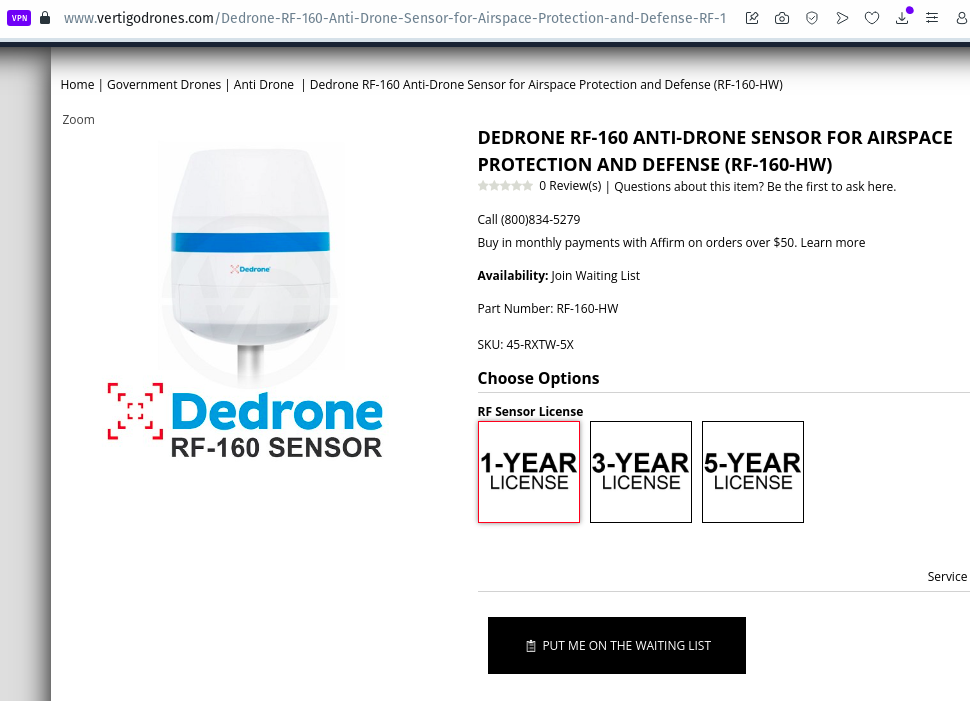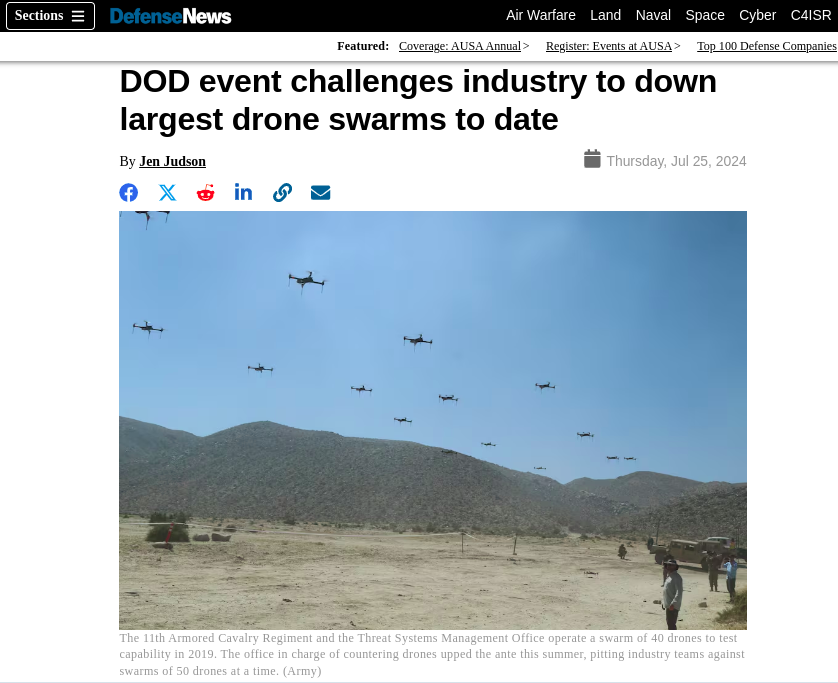Not sure if you've been watching TV or on Social Media any to see the influx of news of drones swarming over American Army air bases, R&D facilities, neighborhoods, etc. Who knows for now what those drones are doing, but what is certain is that is it better to be prepared for Civil & Personal Defense.
As advanced as the government is, it still needs the help of the public to detect and eradicate threats efficiently before any reconnaissance or damage is done to Critical & Public Infrastructure millions rely on to live on a daily basis specially in the winter ..
Counter-drone technology for civilians has developed quickly as drone threats become more common in some areas and for some people in danger of a single FPV or Drone Swarm attack without law enforcement miles away in desolate areas of the country for example. According to Google A.I. "No, it is not legal for a civilian to shoot down a drone in the United States. Here are some reasons why:
- Drones are aircraft: The Federal Aviation Administration (FAA) regulates all national airspace, including the airspace above private property. Damaging or destroying an aircraft is a criminal offense under federal law.
- Property damage: Shooting down a drone can result in charges of property damage and reckless endangerment.
- Violation of federal aviation laws: Shooting down a drone is a violation of federal aviation law.
If you think you're being spied on by a drone, you can try these steps: Contact local law enforcement, Use a radio counter-surveillance system, Use the DroneWatcher app, RF sensors, and radar detectors. If a neighbor is flying a drone over your property, you can try these steps: Contact your neighbor, Ask politely that your neighbor stop flying the drone over your property, and File a lawsuit"
Here’s an overview of affordable and accessible options in electronic mitigation, effective firearms, and general civilian defenses for drone swarms in 2024 in light of federal and local laws for a extreme/doomsday scenarios only (see FAA laws below)...


WARNING - Consult with your local jurisdiction/laws on the legality of self-defense as it relates to you and your areas before reading on to make sure you stay within the bounds of the law for Self-preservation & Civil Defense purposes only in extreme survival cases if justified and ethical. You have been warned. So read on!
Under current Federal Aviation Administration (FAA) regulations and U.S. law, civilians are largely restricted from taking direct action, like shooting down drones, due to strict federal regulations regarding airspace. Here’s a breakdown of the FAA's stance on civilian defense against drones and the legal justifications in extreme, doomsday scenarios:
1. FAA Regulations on Civilian Interference with Drones
The FAA considers all U.S. airspace (including low-altitude airspace) under federal jurisdiction, meaning that any interference with an aircraft—defined to include drones—can have serious legal consequences. Specifically:
- 18 U.S.C. § 32: This federal law makes it illegal to damage or destroy any aircraft, which includes drones. Civilian actions that harm, intercept, or interfere with the operation of a drone can be seen as a violation, potentially carrying severe penalties including prison time.
- Federal Wiretap Act (18 U.S.C. § 2511): This law restricts electronic interception of communications, which can include attempts to jam or otherwise disrupt the signal between a drone and its operator.
- FAA Reauthorization Act of 2018: Section 366 specifies that only federal agencies, like the Department of Homeland Security (DHS) or Department of Justice (DOJ), are authorized to deploy counter-drone technology in the United States. Civilians and even local law enforcement agencies cannot legally use jamming devices or other countermeasures against drones.
The FAA’s enforcement policy is strict because of potential public safety risks, property damage, and privacy concerns.
2. Justifications for Drone Defense in Self-Defense Situations
The legal grounds for taking down a drone in a self-defense scenario are extremely limited, but some arguments can be made based on property and privacy laws:
- Trespass and Privacy Laws: In some states, there are laws that protect homeowners against trespassing drones. For instance, certain states (such as Oregon and California) allow landowners to sue for civil trespass if a drone intrudes on their property in a way that invades their reasonable expectation of privacy. However, these laws usually permit civil litigation rather than physical interception of the drone.
- Castle Doctrine and Self-Defense: While the “Castle Doctrine” allows for self-defense within one’s home, it has not been legally extended to the right to shoot down drones. In most cases, a drone must present an immediate, credible threat to personal safety (e.g., weaponized payload or physical harm to people) to potentially justify extreme actions under self-defense. However, any such action is likely to result in legal scrutiny due to the strong federal protections for aerial vehicles.
3. Extreme “Doomsday” or Self-Preservation Scenarios
In extreme, doomsday-type scenarios, where law enforcement or military responses are compromised, traditional legal restrictions might not apply. While this remains a gray area without specific legal precedents, there are arguments that could theoretically support self-defense actions:
- Necessity Defense: This legal defense, though rarely applied, allows for illegal actions if they are deemed necessary to prevent a more serious harm. In a scenario where a drone poses an immediate and significant risk (e.g., weaponized drones in a civil unrest or doomsday situation), a necessity defense might be used to argue that intervening was required to protect life. However, the burden of proof would be high and subject to post-incident legal review.
- Martial Law or State of Emergency: If martial law or a declared state of emergency suspends certain federal regulations, there may be limited allowances for self-preservation actions. However, this would depend entirely on government directives at the time and could vary by state or local jurisdiction.
Key Legal References
- FAA’s UAS Guidelines: The FAA explicitly restricts the use of counter-drone technology by private citizens and emphasizes penalties for unauthorized interference with drones.
- 18 U.S.C. § 32 (Destruction of Aircraft): This statute defines drones as aircraft, making it illegal to shoot down or destroy them.
- Fourth Amendment Rights and Property Laws: Some states support privacy and property laws that allow action against trespassing drones, but only through civil litigation or law enforcement intervention.
In general, civilians should exercise extreme caution before taking any defensive action against drones and should rely on local law enforcement whenever possible.
1. Electronic Counter-Drone Systems
Electronic countermeasures against drones aim to disrupt communication links between the drone and its operator or interfere with the drone's navigation systems. Some affordable civilian-use devices include:
- DroneGun MKIII: This handheld jammer is compact and user-friendly, with effective jamming capabilities for smaller commercial drones. It disrupts both control and GPS frequencies, which often forces the drone to land or return to its starting point.

- Droneshield RF-160: Affordable and portable, this device detects and disrupts drones within a limited range. It doesn’t require special training and can provide interference at common control frequencies.

- SkySafe Portable / Software: A portable RF jamming solution, if legal if your area/region, for high power applications and portability will help you get the job done .. it can be an effective strategy for short-range scenarios where interception of multiple drones is needed ... check it out!
Additionally, the cost of a SKYNET Drone Defense system varies depending on the material and quantity purchased. For example, a 3-pack of zinc SKYNET Drone Defense costs $39, while a 10,000-pack costs roughly $118,000.
SEE: DIY A.I. solutions for running your own drone swarm to experiment locally ...
For safety and legal compliance, check local laws on the use of radio frequency jamming devices, as they are often regulated.
2. Affordable Rifles for Drone Defense
While firearms aren’t an ideal primary counter-drone measure due to legality, accuracy, and safety concerns, they can play a role in emergency or rural defense situations:
- .22 LR and .223/5.56 AR-15 Platforms: These are commonly available, affordable, and offer sufficient accuracy to target low-altitude drones. Rifles chambered in .223 or .22 LR can work if the drone is close enough and the operator has experience in tracking fast-moving targets.
- Air Rifles: High-powered air rifles with scopes are an affordable option for rural areas in a doomsday scenario. While they have limited range, they can neutralize smaller, low-flying drones effectively if engaged at close range IN your home.

- Shotguns (12-gauge): Shotguns with birdshot or even buckshot are practical for short-range engagements with drones. They offer a spread that makes hitting a fast-moving target easier, especially under 50 yards if ever attacked by a drone or swarm without communications to reach the FAA and/or appropriate law enforcement agency. See applicable FAA laws highlighted above!

3. Other Civilian Defense Measures
- Net Guns: These devices are designed to entangle and bring down small drones within close range. Models like the SkyWall 100 are affordable and non-lethal, suitable for short-range use.
- Hawk and Falconry Programs: Some high-security facilities have trained birds of prey to intercept and disable drones in an eco-friendly manner, and this option can be surprisingly practical for rural or agricultural properties.
- Drone Interception Drones: Some civilian-grade interceptor drones come equipped with net-launching attachments that can effectively down smaller drones by tangling them in a net. These drones are programmed to autonomously track and intercept intruding drones.
Additional Tips for Defending Against Drone Swarms
- Perimeter Awareness and Early Warning Systems: Use affordable perimeter cameras, RF detection devices, or motion sensors to detect incoming drones early.
- Laser Pointers: High-powered laser pointers can help disorient small drones’ optical systems, though this is generally a temporary measure.
- Legal Considerations: Local drone laws often prohibit unauthorized jamming or shooting down drones. Make sure to understand local regulations before implementing any measures involving firearms or electronic jamming.
These methods offer an affordable range of options to mitigate the threat of civilian drones, though they are generally limited to smaller, commercially available drones rather than military-grade UAVs.
The list above is by no means comprehensive and you should read FAA laws regarding drones and self-defense, if attacked by a swarm with no law enforcement around and running is not an option! ...
SOME BELIEVE HE'S STILL ALIVE | Pakistan: on the trail of Bin Laden ...
The government intends to beef up its defense strategy going forward with drone swarms:
NOTE: DYOR. Do your own research, and lookup applicable laws before tinkering with any of these technologies and consult with a lawyer or legal counsel if need be before proceeding with preparations related to Civil/Perimeter Defense. We are not liable or responsible for how you use this information as we are warning you about the legal repercussions and severity of violating FAA regulations related to U.S. airspace and drones!

